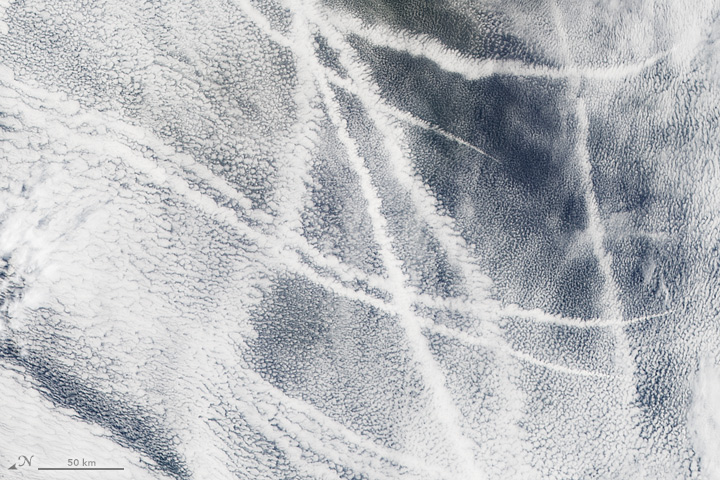Trail from Ship Exhaust Leaves 'A' in the Sky

You may not have seen it, but in July there was a large "A" written in the sky over the ocean near the Kamchatka Peninsula, in far-eastern Russia. In an image of this "A" that was snapped from space, the letter looks like it could have been made by an airplane that was using standard skywriting.
But actually, ships crossing the ocean were responsible for creating the streaky, white letter.
The image of the A, published on Sunday (Dec. 27) on NASA's Earth Observatory website, shows how ocean-going ships produce a stream of exhaust gases that leaves tracks across the sky behind them, called ship tracks. A camera aboard NASA's Aqua satellite took the image on July 27. [Image Gallery: Sunrises and Sunsets]
Not only can ship tracks produce interesting imagery in the sky, but they can also give scientists the opportunity to see how exhaust fumes affect cloud formation over the ocean. Clouds over the ocean are influenced by fewer environmental factors than clouds that form over land, according to NASA's website.
NASA scientists who study climate have discovered that pollution from burning fossil fuels produces aerosols, which are solid, airborne particles that can change what clouds are made of and how they form. Aerosols influence cloud formation and come from many sources, including natural ones such as volcanic activity and algal blooms, according to NASA.
However, the aerosols from burned fossil fuels, such as sulfate particles, have built up in Earth's atmosphere over time and have actually made clouds brighter, leading them to reflect more solar radiation than they used to. While this may sound like a good thing in today's warming world, it is actually changing clouds in negative ways, such as stopping them from releasing water, and researchers don't yet understand how far the effect might go, according to a report from the Intergovernmental Panel on Climate Change (IPCC).
NASA researchers hope that by continuing to study ship tracks, they can help climate scientists gain more insight into how aerosols from burned fossil fuels affect cloud formation, and what any changes they observe mean for the climate going forward.
Get the world’s most fascinating discoveries delivered straight to your inbox.
The image of the letter A was posted as part of NASA's Reading the ABCs from Space project.
Follow Elizabeth Newbern @liznewbern. Follow Live Science @livescience, Facebook & Google+. Original article on Live Science.
